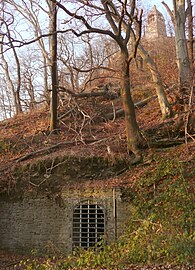Timmerbeil mine
| Timmerbeil mine | |||
|---|---|---|---|
| General information about the mine | |||
| Tunnel mouth hole of the Timmerbeil colliery | |||
| other names | Timmerbeul colliery | ||
| Mining technology | Underground mining | ||
| Funding / year | up to 4175 t | ||
| Information about the mining company | |||
| Employees | up to 16 | ||
| Start of operation | 1828 | ||
| End of operation | 1856 | ||
| Successor use | Timmerbeil colliery civil engineering | ||
| Funded raw materials | |||
| Degradation of | Hard coal | ||
| Geographical location | |||
| Coordinates | 51 ° 25 '31.1 " N , 7 ° 21' 7.6" E | ||
|
|||
| Location | Hohenstein | ||
| local community | Witten | ||
| District ( NUTS3 ) | Ennepe-Ruhr district | ||
| country | State of North Rhine-Westphalia | ||
| Country | Germany | ||
| District | Ruhr area | ||
The Timmerbeil colliery in Hohenstein is a former hard coal mine . The mine was originally named Timmerbeul colliery after the name of Muter .
Mining history
In 1729, the field in which the later colliery mined was already being mined for a short time. On January 10, 1749, the request was made . On January 28, 1823, a length field with the name Timmerbeil was awarded . The award was made for the seams Timmerbeil ( Mausegatt ) and Knappsack (Kreftenscheer). The mine was put into operation in June 1828. The construction of a tunnel was started, the tunnel mouth hole was north of Kohlensiepen on today's Wetterstrasse. In 1840 a new tunnel was built. In 1842 the mining of the Kreftenscheer seam was taken over by the Knappsack colliery . In 1844 a deeper tunnel was created on the Hohenstein. The tunnel was driven in the Kreftenscheer and Mausegatt seams . In 1847, the upper daily operation was set in the Siepental. This daily operation was driven across to open up the Geitling and Kreftenscheer seams. In 1849 the mine received a rail connection. In 1851 research work was carried out, this work served to prepare for a later civil engineering . In the 3rd quarter of 1853 the mine was shut down. On September 20 of 1856 consolidated the bill Timmerbeil with the mines knapsack and Theodora to Timmerbeil civil engineering bill . The purpose of this consolidation was the joint transition to civil engineering.
Promotion and workforce
The first production and workforce figures date from 1830, 20,871 bushels of hard coal were mined. The workforce fluctuated this year between five to ten miners . In 1835, 14,896 bushels of hard coal were mined. In 1838 the production was 2,726 ½ tons of hard coal, the workforce was three employees. In 1840 the production rose to 3,903 Prussian tons of hard coal. In 1845, 16 employees mined 52,998 bushels of hard coal. In 1847 the production was 79,962 bushels of hard coal, the workforce was 16 employees. In 1850 3529 tons of hard coal were mined. In the following year, 4175 tons of hard coal were mined. These are also the last known figures for the mine.
literature
- Joachim Huske : The coal mines in the Ruhr area. Data and facts from the beginning to 2005 (= publications from the German Mining Museum Bochum 144). 3rd revised and expanded edition. Self-published by the German Mining Museum, Bochum 2006, ISBN 3-937203-24-9 .
Web links
- Early mining on the Ruhr: Timmerbeil colliery (accessed on July 26, 2013)
- Early mining on the Ruhr: Historical map around 1840 (accessed on July 26, 2013)
- Early mining in the Ruhr: Map of the situation around 2000 (accessed on July 26, 2013)
Remarks
- ↑ In mining, a daytime operation refers to a level or sloping stretch that has been driven from below to above ground . In rare cases, day drives are also driven from above to below ground. (Source: Tilo Cramm, Joachim Huske: Miners' language in the Ruhr area. )
- ↑ The direction that runs horizontally across the longitudinal axis of the deposit is referred to as cross-cutting . (Source: Förderverein Rammelsberger Bergbaumuseum Goslar eV (Ed.): Ore mining in Rammelsberg. )

